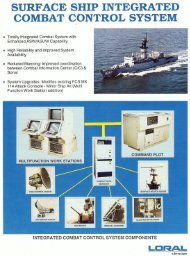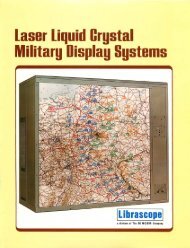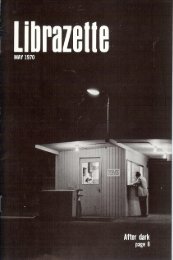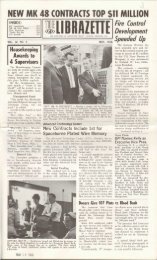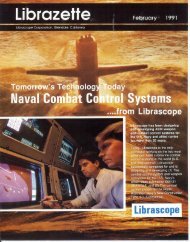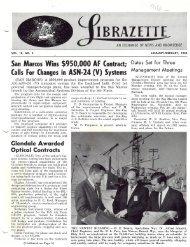Technical Review - Fall 1959. - Librascope Memories
Technical Review - Fall 1959. - Librascope Memories
Technical Review - Fall 1959. - Librascope Memories
Create successful ePaper yourself
Turn your PDF publications into a flip-book with our unique Google optimized e-Paper software.
ORIFICE CONSTANT<br />
MULTIPLYING FACTORS<br />
PROGRAMMED SELECTION<br />
O<br />
—•-<br />
" 72-CHANNEL RELAY<br />
COMMUTATOR<br />
AGE DIGITIZER<br />
DIGITAL CLOCK<br />
INPUT/OUTPUT LOGIC AND<br />
ARITHMETIC AND CONTROL<br />
CIRCUITS<br />
VJII<br />
FLEXOWRITER<br />
INPUT POTENTIOMETERS FOR STATIC PRESSURE,<br />
DIFFERENTIAL PRESSURE, AND TEMPERATURE<br />
MEASUREMENTS<br />
4096-WORD MAIN MEMORY<br />
LIBRATROL-500 Computerized Process Control System<br />
For On-Line Gas Dispatching Control<br />
for each metering point every six minutes<br />
and the average of the values over an<br />
hour period is used to compute the flow.<br />
The orifice flow constant, C', is defined<br />
as the rate of flow in cubic feet<br />
per hour under base conditions when the<br />
^/h w p ( equals one. The orifice flow constant<br />
is a function on some nine flow and<br />
orifice parameters, all of which must be<br />
considered in computing the values of<br />
the constant.<br />
The nine parameters affecting the<br />
value of the orifice flow constant are<br />
basic orifice factor, Reynolds number,<br />
expansion factor, pressure base, temperature<br />
base, flowing temperature, specific<br />
gravity, super-compressibility, and manometer<br />
factor.<br />
These factors influence the value of<br />
the constant in rather complex ways and<br />
the computer has been programmed to<br />
compute the effects of the factors and<br />
the final value of the constant.<br />
"Doubles in brass"<br />
The extreme speed at which the computer<br />
can complete the monitoring and<br />
calculations involved in determining the<br />
demand leaves it with approximately five<br />
minutes out of every six free to accomplish<br />
additional computing tasks. To take<br />
full advantage of this, the utility is programming<br />
the computer to carry out<br />
the prime objective of demand calculations,<br />
and in addition, perform valuable<br />
engineering calculations for several other<br />
divisions of the Public Service Company.<br />
A "time box" program has been established<br />
to set up a priority sequence<br />
of programs for the computer to follow.<br />
This program makes it possible for the<br />
computer to perform the monitoring and<br />
calculation during each sixth minute and<br />
again at the end of the hour. It then<br />
takes up additional computational work<br />
in the vacant five minutes between sampling<br />
periods.<br />
One of the most important engineering<br />
problems which the computer aids<br />
in solving is the analysis and design of<br />
the gas distribution system. The multitude<br />
of various main sizes, which carry<br />
the gas to all points of the system, present<br />
a maze of paths, intersections and<br />
return paths which must be continuously<br />
analyzed to determine the effects of new<br />
service areas and new supply points on<br />
pressure and demand.<br />
A mathematical technique called the<br />
Hardy Cross method formerly enabled<br />
the distribution engineers to analyze the<br />
overall system, but the method required<br />
a tremendous number of trial and error<br />
cycles of computations. On a time basis<br />
alone, the performance of these computations<br />
by the human dispatcher was<br />
virtually impossible.<br />
While the computer cannot display<br />
the originality or creativity of its human<br />
operators, it does excel in the area of<br />
rapid and accurate calculation. For this<br />
reason the Hardy Cross technique is<br />
used quite successfully in the computer.<br />
Rapid and accurate analysis of the distribution<br />
system performance aids the<br />
Denver area by providing increased and<br />
more reliable gas service.<br />
Ability to "grow" with demand<br />
One of the big advantages of the<br />
LiBRATROL-500 system is that management<br />
may install the equipment at early<br />
and less sophisticated stages of process<br />
plant development, and utilize the results<br />
to install more fully automatic control<br />
as the process requirements are evaluated.<br />
In many cases, such a system could<br />
be utilized to monitor pilot and short<br />
runs to establish basic operating criteria.<br />
The system is used by the Public<br />
Service Company for the basic mode of<br />
monitoring and calculating. It may also<br />
be used for the more sophisticated computer-directed<br />
control. In that mode, the<br />
system is used to calculate, on the basis<br />
of data monitored by the instrumentation<br />
and information stored in the computer,<br />
what the optimum set-points in the<br />
process should be to realize maximum<br />
efficiency, maximum output, or to reach<br />
a desired condition in minimum time.<br />
This information is presented to the operator<br />
to permit him to alter the controls<br />
manually to meet the conditions directed<br />
by the computer.<br />
In processes where the relationship<br />
between the primary and secondary<br />
effects of control variations are understood,<br />
the LiBRATROL-500 system is used<br />
in full automatic eontrol o'f the process.<br />
With the control loop closed through<br />
the computer, automatic trimming operations<br />
are carried out by monitoring<br />
set-points and changing them as required.<br />
The LiBRATROL-500 computerized<br />
process control system incorporates a<br />
high-speed digital computer which was<br />
designed to handle three factors: a large<br />
number of variables, the requirement for<br />
intermittent information storage, and the<br />
rapid computation of process problems.<br />
Backing up the computer is a wide<br />
range of input-output equipment which<br />
creates a logical controls system without<br />
excessive instrumentation. The control<br />
system is especially suitable for use in<br />
petroleum and chemical industries, gas<br />
and electric utility plants, in steel mills<br />
and the aircraft industry. A new, and<br />
growing, use is in atomic energy plants<br />
where remote control is a necessity.




